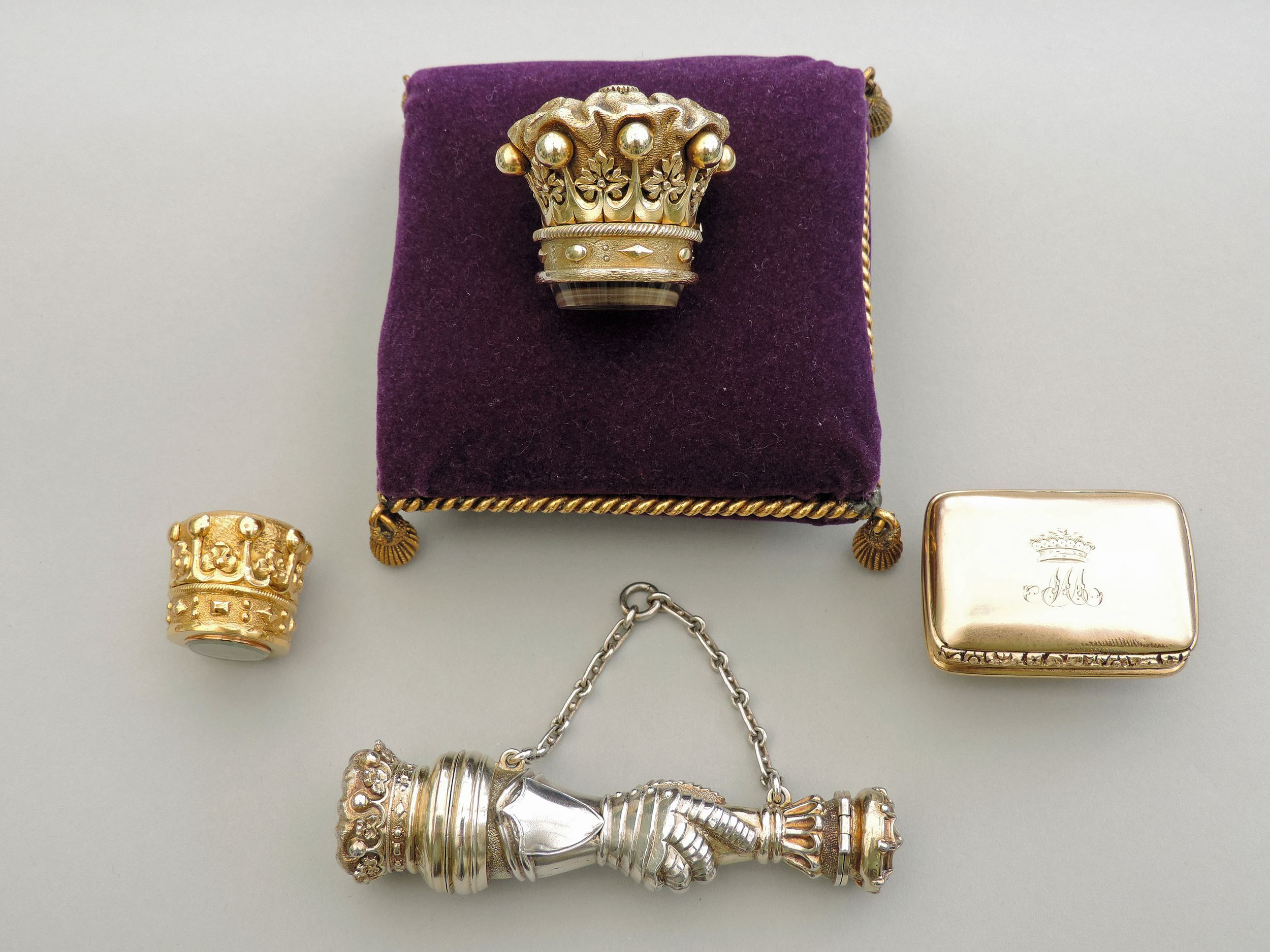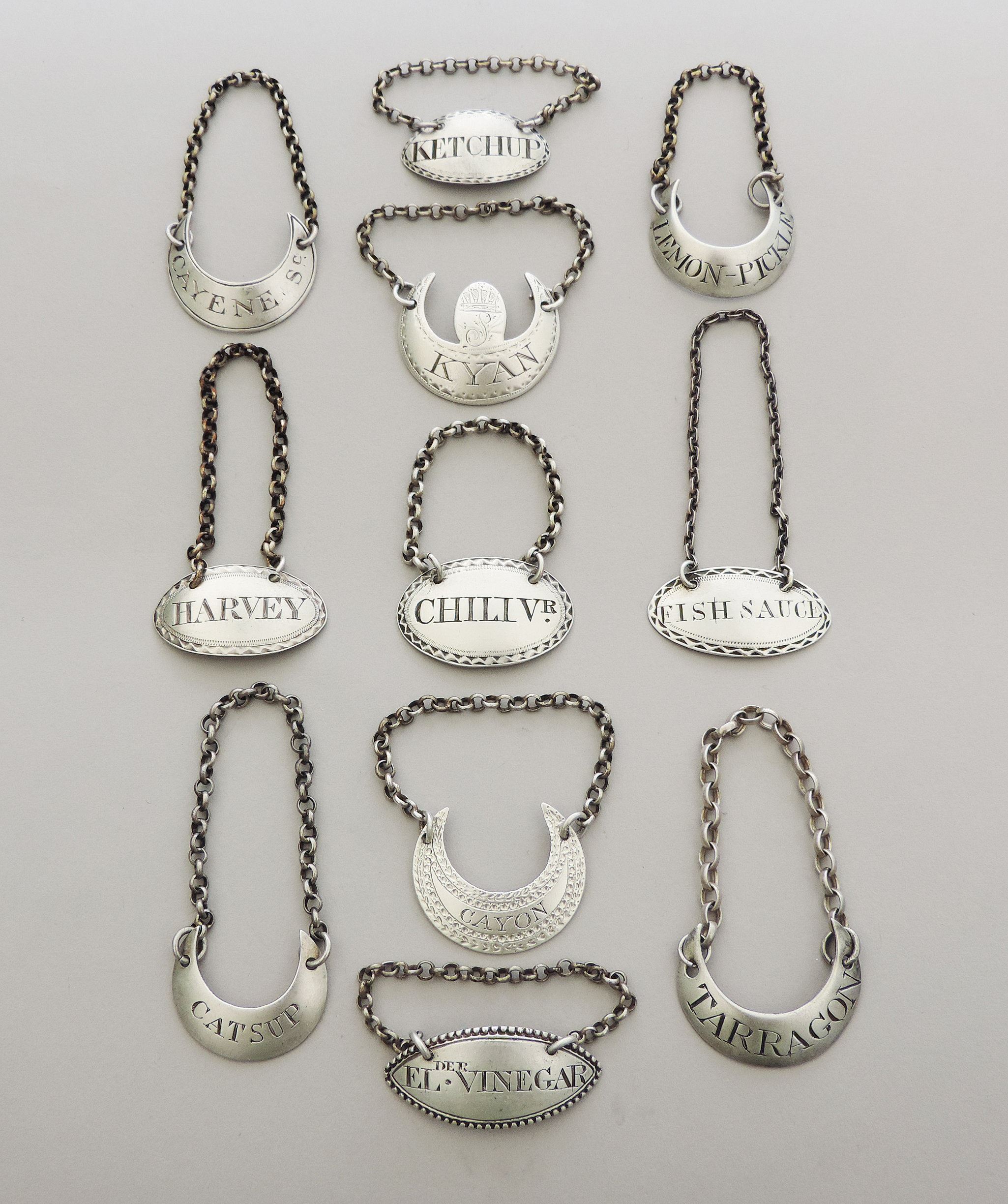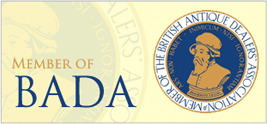|
Steppes Hill Farm Antiques Newsletter #72 - August 2017
|
 |
“Heraldic Coronets & Vinaigrettes, Pearls
& Strawberry Leaves”

(Click on the above image to zoom)
A coronet is a small crown consisting of ornaments fixed on a metal ring. By one definition, a coronet differs from a crown in that a coronet never has arches, and from a tiara in that a coronet completely encircles the head, while a tiara does not. By a slightly different definition, a crown is worn by an emperor, empress, king or queen; a coronet by a nobleman or lady. The main use is now actually not on the head (indeed, many people entitled to a coronet never have one made; the same even applies to some monarchs' crowns, as in Belgium) but as a rank symbol in heraldry, adorning a coat of arms.
In the United Kingdom, a peer wears his or her coronet on one occasion only: for a royal coronation, when it is worn along with coronation robes, equally standardised as a luxurious uniform.
In the peerages of the United Kingdom, the design of a coronet shows the rank of its owner, as in German, French and various other heraldic traditions. Dukes were the first individuals authorised to wear coronets. Marquesses acquired coronets in the 15th century, earls in the 16th and viscounts and barons in the 17th. Until the barons received coronets in 1661, the coronets of earls, marquesses and dukes were engraved while those of viscounts were plain. After 1661, however, Viscomital coronets became engraved, while baronial coronets were plain. Coronets may not bear any precious or semi-precious stones.
- The coronet of a Duke (a silver-gilt circlet, chased as jewelled but not actually gemmed) has eight strawberry leaves of which five are seen in two-dimensional representations.
- The coronet of a Marquess has four strawberry leaves and four silver balls (known as "pearls", but not actually pearls), slightly raised on points above the rim, of which three leaves and two balls are seen.
- The coronet of an Earl has eight strawberry leaves (four visible) and eight "pearls" or balls raised on stalks, of which five are visible.
- The coronet of a Viscount has sixteen "pearls" or balls touching one another, nine being seen in representation.
- The coronet of a Baron or Lord of Parliament in the Scots peerage (a plain silver-gilt circlet) has six "pearls" or balls of which four are visible.
Since a person entitled to wear a coronet customarily displays it in his or her coat of arms above the shield and below the helm and crest, this can provide a useful clue as to the owner of a given coat of arms. 
Featured Item

This months featured item is a small collection of English Silver Sauce or Condiment Labels. They include some rare and unusual titles and a couple with interesting provenances. The details are as follows: -
A rare George III Armorial Silver Sauce Label of crescent form with bright-cut engraved border, an oval cartouche surmount engraved with an Earls Coronet and cypher. Incised for KYAN, by Susanna Barker, London c1780. The Coronet and cypher for Earl Spencer, Viscount Althorp, probably for George John Spencer, 2nd Earl Spencer, KG, PC, DL, FRS, FSA (1 September 1758 – 10 November 1834
A rare George III Silver Sauce Label of crescent form with unusual double chased border of heart shaped leaves and berries, incised for CAYON, by Margaret Binley, London c1775.
An extremely rare George III Provincial Silver Sauce Label of plain crescent form with single reeded border, incised for CAYENE Sc, by John Hampston & John Prince, York c1790.
A rare George III Silver Sauce Label of plain crescent form, incised for CATSUP, by Peter & Ann Bateman, London 1798.
A good George III Silver Sauce Label of plain crescent form, incised for TARRAGON, by Robert Hennell I, London c1790.
A fine George IV Silver Sauce Label of oval form with bright-cut engraved border, incised for HARVEY, by John Reily, London c1823.
A rare George III Silver Sauce Label of plain crescent form, incised for LEMON-PICKLE, by Robert Hennell I, London c1790.
A George III Silver Sauce Label of oval form with bright-cut engraved border, incised for KETCHUP, by Phipps & Robinson, London c1790.
A fine early Victorian Silver Sauce Label of oval form with bright-cut engraved border, incised for CHILI VR, by Rawlings & Summers, London 1839.
A rare George III Silver Sauce Label of oval form with bright-cut engraved border, incised for FISH-SAUCE, by James Hyde, London c1785.
An extremely rare George III Silver Sauce Label of eye shape with beaded border, incised for ELDER * VINEGAR, by Susanna Barker, London c1780.
 |
 |
| |
 |
 |
 |
 |
| Victorian Silver & Enamel Racing Scene Vesta Case |
George III Silver Swing Handled Cake Basket |
Victorian Silver & Essex Crystal Dog Kennel Vesta Case |
George IV Silver 'Pedlar' Snuff Box |
| |
 |
 |
 |
 |
| Victorian Silver Castle-Top Card Case "Queens College Cork" |
Enamelled French Tricolour Flag Silver Gilt Bookmark / Pencil |
George IV Large Silver Bosuns Whistle |
Victorian Novelty Cast Silver Crouching Bear Pepper |

I do hope that you will find this Newsletter informative and helpful and will allow us send it to you on a regular basis. I would welcome any feedback you may have, both positive and negative.
David W.A. Buck.
Steppes Hill Farm Antiques |
|

 |
 |
|

